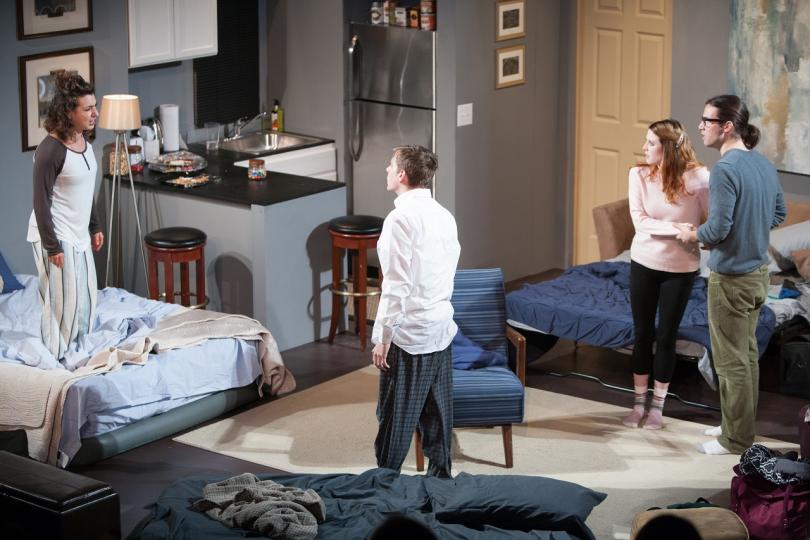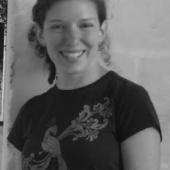Conflict is good

Growing up in a secular Jewish household in New York – in fact, with a parent whose office is five blocks away from the Upper West Side setting of Bad Jews – you’d better believe I learned how to argue. Arguing together around the dinner table was a form of family bonding. I never had a Bat Mitzvah, but I knew I had hit adulthood when I could score points on my older sister, and later, even my dad.
Although my parents were far better versed in Karl Marx than in the Talmud, I trace this kind of heated intellectual dispute back to its cultural roots in rabbinical debates. It wasn’t until I left New York that I realized that, for some people, that kind of conversational crossfire sounds a whole lot like fighting.
But it still surprised me, on my way out of Bad Jews, to hear some of the other audience members’ shock and dismay at how intense the play was. Yes, it was intense – but to me, it wasn’t shocking. The heated sparring went far beyond anything that would’ve gone on around my kitchen table, but it wasn’t out of the realm of possibility. Actually, it was pretty invigorating.
Joshua Harmon’s Bad Jews belongs to a genre of theater that I’m usually a bit skeptical of: the hyper-realistic drama that takes place in an apartment (often in New York) and uses its characters as mouthpieces to battle it out over ideological questions. I’ve seen enough of these plays devolve into a shouting match between one-dimensional stereotypes to wonder why the genre is so popular at all.
Jewish debate is drama
But Bad Jews has a lot going for it, starting with its subject matter. The central conflict is between two cousins, Daphna and Liam, with vastly different interpretations of their family legacy both as Jews and as descendants of a Holocaust survivor. If this play wasn’t all about Judaism (and if it wasn’t so well-directed), I might be more annoyed at its structure, but the tradition of Talmudic debate seems to justify Harmon’s genre choice. For Daphna and Liam, there probably wouldn’t be any less combative way for them to resolve their differences.
Hayley Finn’s masterful direction also carefully avoids all the typical pitfalls of the talking-heads genre of theater. The rare moments that the actors do raise their voices are well-chosen, so the audience doesn’t feel like they are being shouted at for ninety minutes straight. And the blocking is varied and interesting, making the studio apartment feel appropriately claustrophobic without making the action too static.
The set, designed by Michael Hoover with props by Robert J. Smith, could not be more realistic, right down to the pull-out couch cushions propped up in a corner and the multiple hangers lined up in the coat closet. This is a distraction, but not detraction, from the fact that Bad Jews is a talky play. The apartment grounds its characters in their physical, material realities, and its realistic details also resonate in the script, which touches on class issues as well as religious ones.
Emotional grounds for talking like jerks
When you get right down to it, though, what makes Bad Jews more than a scripted debate on Jewish cultural identity is its actors, who make it clear that while most of them are being absolute jerks to one another, they have strong emotional grounds for doing so. Daphna clings to her Jewish heritage with a fervor that borders on supremacist ideology, but Miriam Schwartz, who plays her, also imbues the role with a need for belonging and mastery over her world. Liam, on the other hand, doesn’t feel Jewish at all, but Michael Hanna gives the character room for both serious cultural blind spots and real compassion.
As Liam’s brother Jonah, who just wants to stay out of the conflict, Michael Torsch has one of the hardest parts to play. Both in real life and for his character, it can be tricky to stay attentive to a rapid-fire argument without getting sucked into the middle of it. Watch Torsch’s facial expressions during the play: although he has many fewer lines, he is just as present and interesting to watch as everyone else, and in many ways serves as an anchor to keep everyone else from going too far off the rails.
And finally, Adelin Phelps really surprised me as Melody, Liam’s bubbly “just American” girlfriend from Delaware. I feared that was all Melody would be, but Phelps does an excellent job conveying all of the emotions that can lie under an ever-chipper exterior.
It can be intense to watch someone else’s family argument (or your own, for that matter). But your sensibility might be just a little too Minnesotan if all you see in Bad Jews is the fighting. The whole key to the production’s success is in its well-calibrated balance between each individual’s emotional needs and the intellectual ballast they use to keep themselves afloat.
When symbols matter most
And ultimately, the conflict on stage is less about the particular issues between Liam and Daphna, and more about symbolism on a broader level. Judaism is all about symbols – just consider the meaning behind each item on the Seder plate – but there is still room for its symbolism to resonate differently for different people. That’s why rabbinical scholars can argue about the Talmud for hours without ever reaching a conclusion, and that’s why the conflict in Bad Jews is about more than just who gets to keep a family heirloom or who is a better Jew.
You don’t even need to be Jewish to understand the symbolic questions at stake here. What does it mean to tattoo something onto your body, and how would that change if your grandfather had been in a concentration camp? How can a family heirloom change meanings as it changes hands? Can you honor a family legacy while imbuing it with a more modern interpretation? As a New York transplant to the Midwest, it struck me when watching Bad Jews (though this wasn’t the first time) how much of a person’s identity depends on contrast, only revealing itself through difference and, yes, conflict. But – unlike some of my Midwestern counterparts – I’m pretty sure that not all conflict is a bad thing.




